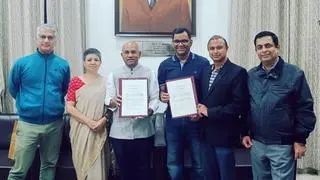Ever since my father bought us our first Tintin – The Black Island – my brother and I have journeyed the world through Herge’s books in the Hebrides, South America, China, Egypt and even the moon. . No wonder we were hushed pilgrims on our journey to Louvain-la-Neuve, a pleasant university town an hour from Brussels, where we were headed to visit the Herge Museum.
From a distance, the Musee Herge looked like a three-dimensional comic plateThe museum unfolded in multiple levels, revealing the complexity of Herge’s seemingly simple art. Floor by floor, we explored Herge’s life through his creations.
The audio guide welcomed us with the cheery Jack Hylton song, “Why Does My Heart Go Boom?” hummed by the Thompson twins in Land of Black Gold . Such attention to detail endowed the first section, ‘A Life's Journey’, with a warm familiarity. Photographs, fragments of interviews, videos and, of course, original sketches covered entire walls.
“If my parents are to be believed, I was never really well-behaved unless I had a pen and paper in my hands...”, said one wall. It was heart-warming to see Herge’s boy scout memorabilia and how the movement's valorisation of courage and friendship manifested in Tintin.
The second section, ‘Man of Many Talents’, had a fabulous collection of Herge’s experiments in other media. Posters, graphic art, postcards, and stamps traced the development of Herge’s artistic idiom: bold colours, clear lines, simplicity and imaginative experimentation with form.
The next few sections paid tribute to Tintin's world. A chandelier made of 200-odd light panels carrying sketches of every single character to ever appear in the series, spanned two levels. ‘Family From the Drawing Board’ lovingly catalogued the major characters. The cast came alive with Herge’s personal comments on each, humanizing and fondly tracing inspirations.
‘Cinema!’ did a great job of presenting films and their influence on many of Herge’s plots and sequence detailing. The panel-by-panel analyses showed how the comic strip, as a form, came into its own through such inter-textual play.
The section that captivated us the most was ‘Dreaming of Travel’. Relics collected from each of the places Tintin visited were displayed along with Herge’s musings on these journeys. We discovered Herge’s apology for his shockingly paternalistic depiction of the Congo, Belgium’s erstwhile colony. Relying on the media of the time, Herge’s panels were coloured by the colonial spirit of the times, lacking actual experience in Africa. Meeting the Chinese student, Chang, changed all of this: Herge's fascination with Chinese poetry and politics, experienced through his close friendship with a native, blossomed into a lifelong respect for different cultures and a desire to avoid stereotypes while depicting them. His panels changed, accommodating more precise detail researched from real sources, be it the crenellations in the Qutub Minar in Tintin in Tibet or the anti-incumbent posters in the streets of a South American city in Tintin and the Picaros .
Ending in a section on the various accolades Tintin received (from people as diverse as Salvador Dali, the Dalai Lama and Charles de Gaulle), our tour left us feeling oddly moved. Sipping a coffee at Le Petit Vingtieme (the museum's cafe named after the newspaper Tintin first appeared in), I mused on how “high” and “low” art sit alongside each other, in pleasant conversation, in Belgium. The intimately Musee Herge is a symbol of this ongoing conversation.







Comments
Comments have to be in English, and in full sentences. They cannot be abusive or personal. Please abide by our community guidelines for posting your comments.
We have migrated to a new commenting platform. If you are already a registered user of TheHindu Businessline and logged in, you may continue to engage with our articles. If you do not have an account please register and login to post comments. Users can access their older comments by logging into their accounts on Vuukle.